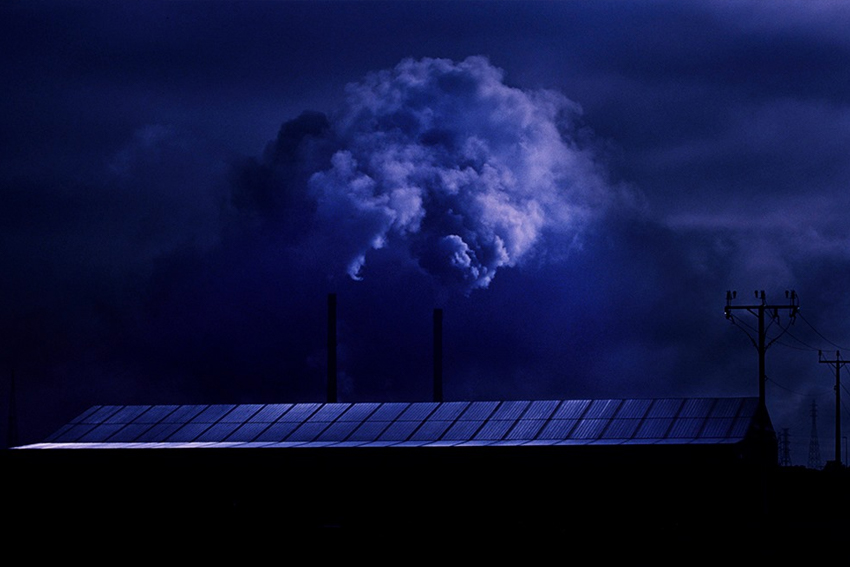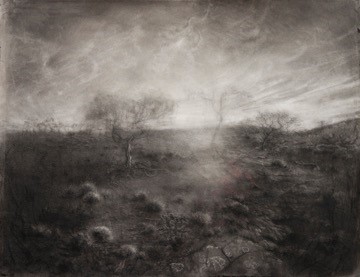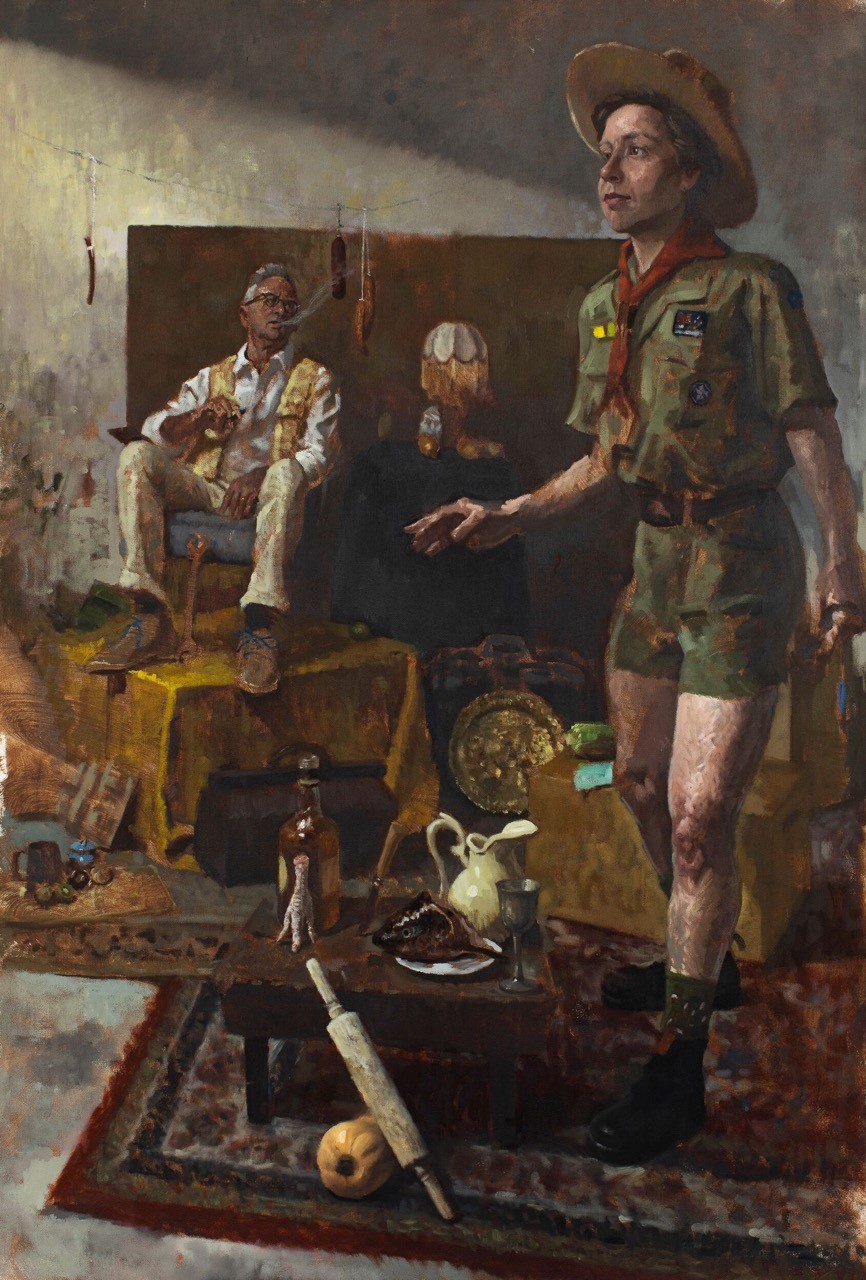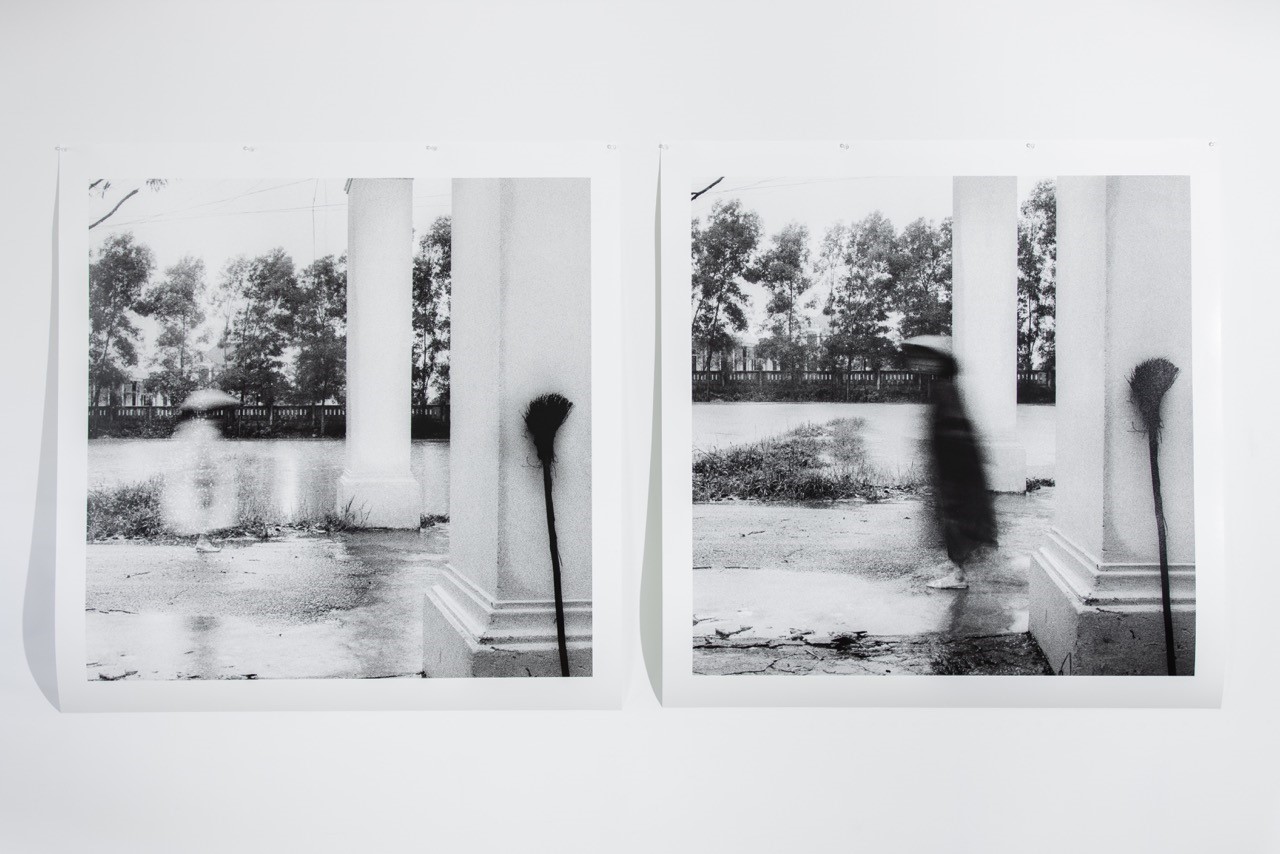Trent Parke: The Crimson Line
Hugo Michell Gallery
31 October to 23 November 2019
Trent Parke’s omnivorous camera devours everything in its path. The heroic scale and diversity of his imagery create immersive experiences in which which one’s awareness of the immediate visual world is constantly churned, and sometimes burnt by the compelling evidence that the simplest things, be it ants swarming around a letter box, or someone waiting for the lights to change, have within them a universe of possibilities. The Crimson Line, his current exhibition at Hugo Michell re-envisages Port Adelaide as the gateway to heaven and hell. Brutal, satanic machines that in the clear light of a midday sun, might reveal themselves and loading derricks and cranes, look like outtakes from The War of the World.
Red clouds boil and smoke stacks belch in half lights that belong to the liminal zones of first and last light of the day. The genius of this series is not that Parke has subjected his industrial subjects to a dose of terrible beauty but that he has wrapped these images in a narrative all about a tiny creature, the cochineal bug, from which the crimson dye carmine is derived. Put that in your chimney and smoke it. To this audacity add Dr Seuss, whose ability to daisy chain illustrations and words to create irresistibly readable rhymes and stories and Parke stands revealed as a master story teller. Little wonder the heart of this exhibition is not necessarily the large photographic prints running in a frieze around the walls but a fold out book in which one (sort of) follows the adventures of a little cochineal bug as it is spat out of a lipstick-like smoke stack to cast its crimson spells on the world – starting with Port Adelaide.
 Trent Parke, Factory 08, 2019, pigment print, 108 x 162 cm.
Trent Parke, Factory 08, 2019, pigment print, 108 x 162 cm.
The Line #2
BMG Art
Margaret Ambridge, Godwin Bradbeer, Kevin Connor, Jason Cordero, Christopher Orchard, Todd Hunter,
25 October – 16 November 2019
Drawing used to be easily defined as lines, tones and shapes on flat surfaces, usually paper but also walls, canvas and so on. Modes of more experimental art practice of the later twentieth century saw drawing relocated into expanded fields which allowed all manner of line-making behaviour such as making pathways by walking backwards and forwards over fields, arranging rocks or leaves in lines, tracking sensors with cameras, rolling paint covered bodies across canvases.
Compared to this, traditional modes like taking a 2B pencil to a piece of paper, began to look historical. But drawing in the sense of that intensely compressed space between artist intent and imprint of gesture, continues to flourish. Even digital drawing a la David Hockney relies on this sense of connection to creative instinct through ‘the touch’. Line # currently at BMG Art is a line-up of exceptional talents which demonstrates that the simplest form of image making is capable of great diversity and visual authority. ‘Bigness’ is front and centre in expansive works by Christopher Orchard and Jason Cordero.
 Margaret Ambridge, A Room of One’s Own, Gawler Ranges v Cyclindraprolifera Profundia ll, charcoal and pastel on paper 69 x 90 cm
Margaret Ambridge, A Room of One’s Own, Gawler Ranges v Cyclindraprolifera Profundia ll, charcoal and pastel on paper 69 x 90 cm
The most compelling of Orchard’s images is Hold 1 composed as a larger than life head study of a man holding his breath to the point of expulsion. The grain of the drawn surface vividly conveys the physicality of the moment. Jason Cordero offers an extended meta narrative running in extended friezes of pen and wash figuration around the walls. This is quite a departure for an artist best known for intense, finely articulated dreamscapes. It’s surrender to the journey time as you pace the floor dipping in and out of fabulist scenarios crowded with metamorphosing trees and languid nudes. Contortion and searching line work feed the complex entwinements of Todd Hunter’s figures.
Margaret Ambridge takes the eye into uncomfortable territory where feral plants prowl post-human landscapes. The delicacy and inventiveness of Ambridge’s charcoal work acts as an effective foil to the darkness of the subjects. Godwin Bradbeer, it seems, doesn’t know how to make an inert image. His figure studies are pumped with skin stretched on sinew and bone vitalityevoked by his tradecraft polishing, abrading and incising mark making. Kevin Connor’s head of an old man, through muscularity of gesture redefines bigness as a quality comes from an inner vision.
There’s a Q&A session at BMG Art with artists from The Line #2 on Saturday 9 November from 3pm.
Andrew Clarke: Arcadian Visions
Sam Hill Smith Gallery
7 – 23 November 2019
Andrew Clarke’s previous outing at Sam Hill Smith (Mephistopheles’ Yellow Vacuum Cleaner) was quite a tour de force in terms of a contemporary reworking of the High Victorian ‘problem picture’ genre with generous nods to 1920s German New Realism, de Chirico, Neo Rauch, Sebastian Schrader, and others. His familiarity with such a diverse menu of realist modes has allowed his subversive wit to shine in images which cast a variety of anti-heroes and bohemians as bit actors in absurdist dramas that have no meaning beyond whatever gesture, pose, costuming and props might suggest. The key to carrying off this sleight of hand has been an assured painterly style, bordering on swagger. This encourages a reading of his work as having some context in earlier European eras associated with the robust painterly work of say, Tintoretto, or a kit bag full of Baroque masters. On reflection there is also echoes of the mannered sketch stylisation of John Singer Sargent’s Venetian and Spanish paintings of the late 1870s.
 Andrew Clarke, Careful not to wake the wildebeest, the hunter checked her traps, 2019
Andrew Clarke, Careful not to wake the wildebeest, the hunter checked her traps, 2019
He states that, “In Arcadian Visions I take as my subject a traditional genre of landscape painting known as ‘the pastoral’ … I have somewhat subverted this handling of the subject matter, introducing elements of vagrancy and delinquency, at times perhaps evocative of a shameful stumble homewards in the early hours of the morning. Despite this, I have sought to retain the lyric and romantic quality that is so present in the works of masters of the genre. A poetic distancing from the ordinary and the now.” If this doesn’t completely explain things get the images to explain themselves to you. Personally they evoke fragmented memories of old tales of sea dogs, fairy stories and classic quests going pear-shaped – and simply playing make believe.
Hold
Curated by Linda Marie Walker in collaboration with artists: Johnnie Dady, Louise Haselton, Rick Martin, Sonja Porcaro
South West Contemporary, 205 Sturt Street
From 2 November
“All artworks have ‘hold’ within them”, says curator Linda Marie Walker, “Personal memories, entangled with memories of labour, of materials and colour and shape, of subject, intention, doubt, failure and time.” The four artists have obliged by presenting work that sits within such broad parameters. Walker again: “ In the five photographs by Rick Martin the act of hold is explicit; it’s the image itself, not just the scene, the elements, the arrangement, but the overall momentary ordinariness”; “ Louise Hasleton’s works ‘hold’ a mix of codes, of languages , of textures that articulate flows and pulses of various simultaneous speeds”; “Sonja Porcaro’s objects are tense and relaxed at once; their energy holds-up movement, arrests passage, as they are distillations of events, of people’s stories, of her stories in relation to their stories”; “ Johnnie Dady’s works are ones of perpetual delay.”
 Rick Martin, Like Falling Rain nos 1&2, 2016, photographs made on film, digitally printed 112 x 112cm
Rick Martin, Like Falling Rain nos 1&2, 2016, photographs made on film, digitally printed 112 x 112cm
With Walker in vintage form, spinning text that corrals this diverse body of work into a cocoon of ambient meanings, this exhibition and its essay mount a persuasive argument for art making based on withholding or suspending closure. In critical writing terms this is often referred to as ‘hovering’ – resisting fixed and final pronouncements in favour of ‘then again’ possibilities. Perhaps an appreciation of this attitude to art making can only shared by artists who continue to ask the hard questions about the the meaning and purpose of making objects. This generation of artists’ faith in the power of visual aesthetics to hold the gaze is an entry point for viewers who might be tempted to look away from works that appear to hold onto their meaning a little too hard.
Head to our Adelaide Review Event Guide to find out what else is happening around the city
John Neylon is an award-winning art critic and the author of several books on South Australian artists including Hans Heysen: Into The Light (2004), Aldo Iacobelli: I love painting (2006), and Robert Hannaford: Natural Eye (2007).
Get the latest from The Adelaide Review in your inbox
Get the latest from The Adelaide Review in your inbox